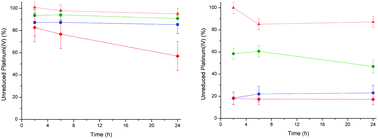The reduction of cis-platinum(iv) complexes by ascorbate and in whole human blood models using 1H NMR and XANES spectroscopy†
Abstract
The efficacy of platinum(IV) prodrugs depends on their relative resistance to reduction in the extra- and intra-cellular environments. In the study reported here we investigated the influence of the nature of the axial and equatorial ligands on the pathway of reduction of the platinum(IV) complexes by the endogenous reductant, ascorbate, and their relative resistance to reduction in human blood serum and in a whole human blood model. The pathway of reduction of platinum(IV) complexes in the presence of excess ascorbate was found to be dependent on the nature of their axial and equatorial ligands in that complexes with chloride in the equatorial sites lost either both axial ligands or combinations of axial and equatorial ligands while those with oxalate occupying the equatorial sites lost both axial ligands only. Using XANES spectroscopy, complexes with axial hydroxide ligands were found to be highly resistant to reduction in blood serum and were only slowly and incompletely reduced in whole blood. The dihydroxide complex with an oxalate ligand occupying the equatorial leaving group sites was more resistant to reduction, both in serum and in whole blood, than the complex with chloride ligands in these sites. cis, trans-[PtCl2(OAc)2(en)] and trans-[Pt(OAc)2(ox)(en)] were observed to be reduced rapidly and almost completely in whole blood but the latter was substantially resistant to reduction in human blood serum, and consequently demonstrates many of the features of an optimal platinum(IV) anticancer agent.



 Please wait while we load your content...
Please wait while we load your content...